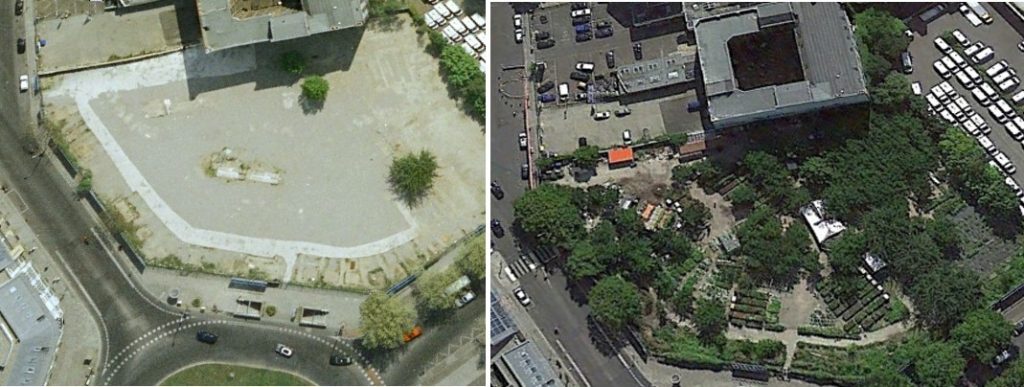
Prinzessinnengarten Berlin, Germany
Launched by Nomadisch Grün (Nomadic Green) in 2009, Prinzessinnengarten Kollektiv Berlin is a project transforming wasted open spaces within Berlin into productive nomadic gardens. All plants are grown in transportable vessels such as potato sacks or milk crates meaning if ever any of the spaces are reclaimed for other purposes the garden can simply be moved to another site. These gardens provide fresh produce to communities in the surrounding neighbourhoods and invite locals to participate in the growing and harvesting of the gardens.

Prinzessinnengarten sites use raised planting beds and other temporary or transferrable containers so they can take up land temporarily. (source: Prinzessinnengarten Kollektiv Berlin 2022)
The kind of sites that the project takes over are unused car parks, building sites and roofs. The ability to move the garden when or if the site is ever needed again means that even if temporary, these spaces in the city are becoming greener, more occupied and aiding in the reduction of the CO2 in the city. Even small plots can be turned into these temporary gardens. These kind of food productive plots would be very useful to consider incorporating into a CPUL because they can be the connecting spaces between larger open areas of productive landscape.

The original Prinzessinnengarten at Moritzplatz within the urban environment (source: Prinzessinnengarten Kollektiv Berlin 2022)
Prinzessinnengarten at Moritzplatz, their main site, hosts not only vegetable patches but cultural events, a cafe and workshops. Across all of their gardens, the project operates on and teaches about circular systems such as greywater treatment and re-use and composting. Overall Prinzessinnengarten Kollektiv Berlin has co-initiated and founded over 140 gardens since 2011 within schools, neighbourhoods, refugee accommodations, company gardens and at cultural and social institutions across Berlin. Now a collective, they aim to ‘increase biological, social and cultural diversity’ across neighbourhoods in Berlin by educating the community in cultivation and providing green spaces for people to work together and relax in an urban environment.

Prinzessinnengarten at the Moritzplatz site before and after development (source: Prinzessinnengarten Kollektiv Berlin 2022)
For further information see the project’s own website.
For updates on Prinzessinnengärten see our news posts.
Image: Prinzessinnengärten’s original sits amongst the city’s buildings (source: DW 2022)
Back to previous page Related information and design projects
